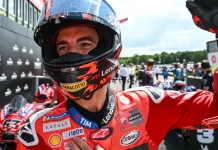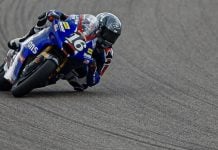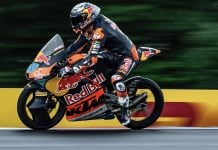From a press release, just arrived:
2002 KAWASAKI MODELS
For 2002, Kawasaki introduces brand-new models targeting a wide range of motorcycle enthusiasts. Like the hot-rod Vulcan, 1500 Mean Streak cruiser, the aggressive ZZ-R1200 sport-tourer and the motocross-inspired four-stroke KLX110.
Kawasaki has also significantly upgraded its performance-leading NINJA® ZX-12R and NINJA® ZX-9R sportbikes to deliver even more power, comfort and style.
For the off-road set, Kawasaki introduces the KLX110 dirtbike. This user-friendly four-stroke trailbike is ideal for providing the fun and excitement of that first off-road riding experience. It combines a durable, four-stroke engine with a slim, downsized chassis, and even features Kawasaki’s lime green motocross-style bodywork. It will please both parents and young riders seeking their first off-road ride.
Click here for photos of the new KLX110.
Receiving major updates for 2002 is the NINJA® ZX-12R, the flagship of Kawasaki’s celebrated Ninja line. This boundary-pushing sportbike is the recipient of 27 modifications and enhancements, all aimed at improving the machine’s overall performance. The upshot is a performance-oriented, cutting-edge motorcycle with an innovative monocoque frame and sleek aerodynamics. Built to deliver the lightest weight and highest power-to-weight ratio of any machine in its class, the ZX-12R provides exceptional stability, nimble handling and comfortable ergonomics, not to mention an exhilarating ride.
Click here for photos of the new ZX-12R.
Likewise, the NINJA ZX-9R enters the new model year after being refined by Kawasaki’s engineers. Styling, engine response and handling were targeted. The result? Now the popular Open-class machine has a more streamlined and aggressive look, and offers competition-style performance with real-world versatility.
Topping this year’s cruiser charts is the Vulcan 1500 Mean Streak performance cruiser. Utilizing its extensive Vulcan heritage as well as intensive engine and chassis improvements, the Mean Streak offers up a hot-rod cruiser attitude but with sportbike-like handling and braking.
Rounding out Kawasaki’s new-for-2002 lineup is the ZZ-R1200 sport-touring machine. Borrowing engine and chassis design from the ZRX1200R and NINJA ZX-11, this new model offers the performance associated with top-shelf sportbikes, but with the comfort of a touring motorcycle.
Click here for photos of the new ZZ-R1200.
More Details By Model:
NEW 2002 KAWASAKI NINJA® ZX-9R
Features improved engine response, sharper handling, and updated styling
The 1984 Kawasaki NINJA® 900R was the world’s first production 16-valve, liquid-cooled, in-line four-cylinder motorcycle, and it was also the world’s first stock motorcycle to exceed 150 mph when evaluated under timed track conditions, putting Kawasaki at the forefront of the next generation of motorcycles. For 2002, Kawasaki continues to extend its performance heritage with the new Kawasaki Ninja® ZX-9R. Combining Open-class performance and real-world versatility, the newest ZX-9R delivers improved engine response, sharper handling, and updated styling in a trim, 404 lb. chassis.
The heart of the ZX-9R is its lightweight, all-aluminum cylinder block, with electroplated lining for wear resistance and superior heat dispersion. The cylinder head itself is shaped to provide a high compression ratio, while the cam timing and profile are designed for abundant torque across the rev range. For 2002, Kawasaki paid particular attention to lower-rpm performance. Engineers increased crank mass by 10 percent by adding material to the crank webs, and decreased the size of the flywheel. Additionally, the flywheel cover is now aluminum instead of magnesium so that it can be more easily modified for racing applications.
Four new Keihin 40mm downdraft semi-flat-slide carburetors deliver excellent throttle response and are equipped with the Kawasaki Throttle Responsive Ignition Control (K-TRIC) system. Linked to the ignition system, K-TRIC adjusts ignition timing for all throttle settings. A 16-bit microprocessor accurately adjusts timing from sensors at both the carburetors and the crankshaft.
Spent gases exit via a four-into-two-into-one exhaust system with a lightweight, all-titanium muffler equipped with the Kawasaki Clean Air System catalyzer (with the exception of California models, which have a stainless-steel unit and an additional catalyzer for reduced emissions).
NEW 2002 KAWASAKI NINJA® ZX-12R
Flagship NINJA model boasts major engine and chassis changes for stronger performance and improved handling
The new-for-2002 Kawasaki NINJA® ZX-12R motorcycle is the latest in a long line of standard-setting Kawasaki sportbikes. Indeed, this performance-defining machine claims as its ancestors a number of boundary-pushing motorcycles, ranging from the legendary H1 to the Z1 and various open-class NINJA models, such as the much-lauded ZX-11. With this impressive lineage in mind, Kawasaki endowed the newest ZX-12R with dozens of modifications and enhancements aimed at improving overall performance.
The result is a powerful, yet user-friendly engine combined with an ultra-responsive chassis for a performance-oriented, nimble-handling and
comfortable ride.
The ZX-12R sportbike’s 1199cc inline-four engine utilizes the same high-performance design found in the class-leading NINJA ZX-9R and ZX-6R models, and produces healthy doses of horsepower.
For 2002, Kawasaki engineers retuned the 16-valve, dohc engine to provide a more tractable power delivery for quicker acceleration. Changes include adding weight to the crank by widening the starter and balancer/primary gears, thus making it easier to pull cleanly away from stops. Adding inertia is a new, narrower flywheel with a smaller diameter and a thicker outer rim. An oval throttle pulley improves throttle control, particularly at low- to mid-range engine speeds. The ignition mapping was also altered to enhance low and mid-range power.
The new motorcycle’s distinctive-looking snout has been updated with a more streamlined nosepiece. This new ram-air duct not only improves the bike’s overall aerodynamics, it also increases the intake area by 30 percent. Ribbing within the ducts improves the ram-air effect at the sides, and offsets wind shear from cross breezes. Quieter, more efficient radiator fans improve cooling at lower speeds, and the front engine mount has been changed from a double to a single hanger to accommodate the two new fans’ locations.
For more positive-feeling gear engagement, the ZX-12R’s six-speed transmission now incorporates less clearance between the gear dogs, and a modified clutch damper helps reduce driveline lash. Also contributing to smoother shifting is a larger-diameter shift shaft. For better overall clutch durability, holes were added to the clutch pull rod and within the clutch hub itself to increase oil flow.
This high-compression engine gets its fuel mixture through a Nippondenso electronic fuel-injection system. Within the four 46mm throttle bodies, the injector tips have four holes to spray fuel directly at the intake valves. Electronic sensors continuously feed the system engine and atmospheric data to control fuel injection and ignition for each cylinder. The result is exceptional throttle response and high output at all engine speeds.
Compact stick-style ignition coils help generate the electrical current to fire the twin-electrode, long-lasting platinum spark plugs. Burned gasses are expelled through a four-into-two-into-one exhaust system featuring stainless steel headpipes and a lightweight, all-titanium muffler.
The ZX12-R is supported by an aluminum monocoque frame that incorporates a cast steering head welded to pressed plates welded to a cast midsection that incorporates the battery case as a stressed member. For 2002, the steering-head bearings are both the same size for lighter steering and a more planted feel. Steering angle has been increased to maintain adequate rake as the suspension is compressed for better turn-in. Fork offset was reduced to keep trail numbers the same.
Kawasaki’s patented UNI-TRAK® rear suspension uses a linkage system to progressively increase the damping and spring rate as the suspension is compressed. For better handling, the extruded-aluminum swingarm pivot was lowered, and the swingarm itself now uses an extruded-aluminum cross brace that was moved 2.5mm forward. The single shock is 5mm shorter than the previous version and has a softer spring. It also features a new stepless damping adjuster, which incorporates a check valve for improved damping performance.
Front suspension is supplied by a 43mm inverted cartridge fork with adjustable preload, compression and rebound damping. For ’02, stiffer settings help prevent front-end dive under braking. Like the rear shock, the front fork uses the new stepless adjuster.
Both ends of the ZX-12R wear 17-inch wheels with hexagonal tri-spokes. The six-inch-wide rear rim is fitted with an ultra-wide 200/50 tire for excellent traction. Braking is accomplished with opposed six-piston calipers gripping large 320mm diameter dual disc front brakes, while a lightweight 230mm single disc is gripped by a lightweight opposed-piston caliper at the rear.
In order to make the ZX-12R as aerodynamic as possible, Kawasaki redesigned its front cowling with a one-point drag coefficient reduction. This new cowling is wider and is equipped with a higher, bubble-type windscreen for better rider protection. Smaller triangular-shaped mirrors are mounted lower on the cowling to aid in aerodynamics and resist vibration-induced blurring. A new three-piece lower fairing assembly with a solid center insert and a new, shorter front fender provide a sportier look.
As the flagship model in the legendary Ninja line, the new 2002 ZX-12R represents the ultimate expression of Kawasaki’s engineering excellence and performance heritage.
2002 NINJA® ZX-12R FEATURES
4-Cylinder 1199cc Engine
· Compact and light weight
· Aluminum cylinders with electroplated bores reduce weight, resist wear and offer superior heat dispersion
· Balancer shaft for smooth running at all rpm
Redesigned Crankshaft
· Increased weight at the crank by widening primary/starter and balancer gears
· Added inertia via narrower flywheel with smaller diameter and thicker outer rim
Enhanced Fuel Injection
· Oval throttle pulley improves throttle control, especially at low to midrange engine speeds
Six-Speed Transmission
· Decreased clearance between gear dogs for better gear engagement
· Modified clutch damper helps reduce driveline lash
· Increased oil flow in the clutch pull rod and clutch hub for extra durability
· Shift shaft diameter increased for better feel
Digital Ignition
· Ignition mapping altered to enhance low and mid-range power
· Independent timing control for each cylinder based on data from several engine and atmospheric sensors
· Stick-type ignition coils are compact and lightweight
Redesigned Fuel Pump/Oil Pump
· Fuel pump regulator mounts on the pump body, eliminating a return line for easier maintenance
· Increased oil pump volume via a wider rotor
Revised Steering Geometry
· Steering angle increased to maintain proper rake when suspension is compressed
· Steering head bearings are the same size for a more planted feel
Redesigned Ram Air Intake
· New ram-air duct improves aerodynamic efficiency and increases intake area by 30 percent
· Incorporates ribs to improve ram-air effect at the sides and offset wind shear from cross breezes
Redesigned Aerodynamic Cowling
· Improves aerodynamics with a one-point drag coefficient reduction
· Wider design and high bubble screen provide extra rider wind protection
· Small, triangular mirrors are mounted lower to help improve aerodynamics
· Cover near the front brake lever reduces turbulence behind the windscreen
43mm Inverted Front Fork
· Fully adjustable spring preload, compression and rebound damping
· Stiffer settings to prevent front-end dive under braking
· New stepless damping adjuster with check valve instead of needle valve for improved damping
Bottom-Link UNI-TRAK® Rear Suspension
· Fully adjustable shock that’s shorter and has a softer spring
· New stepless damping adjuster with check valve instead of needle valve for improved damping
· Swingarm pivot lowered to weight the front wheel
· Swingarm equipped with new extruded-aluminum cross brace that’s lighter and moved forward
Details
· Lowered handlebars for a more planted feel
· Increased wheelbase
· New friction-reducing sealant on the front brake caliper pistons improves brake feel
· Three-piece lower fairing with solid center insert improves aesthetics
· Shorter, sportier front fender
NEW 2002 KAWASAKI NINJA® ZZ-R1200
Puts the “sport” in sport-touring
For the sporting adventurer, the new-for-2002 Kawasaki NINJA® ZZ-R1200 sport-touring motorcycle is the ideal vehicle. Designed specifically for motorcyclists interested in a performance-oriented ride, but who also seek the comfort and style of a bona fide grand-touring bike, the ZZ-R1200 can’t help but please. Originally conceptualized for the European market, the ZZ-R comes stateside with the best of Kawasaki’s ZRX1200R and NINJA ZX-11 traits. The result is a machine that offers sporty handling, a powerful yet user-friendly engine, comfortable ergonomics and an upscale appearance.
Although the ZZ-R1200’s double-overhead-cam 1164cc inline-four engine is similar to that of the ZRX1200R, Kawasaki engineers modified the 16-valve engine to be a stronger performer in the low and midrange sections of the powerband. For starters, the cylinder head is endowed with a new water jacket and head-bolt layout to accommodate a bank of four Keihin 40mm downdraft carburetors. Like the ZRX, the aluminum cylinders themselves utilize electroplating rather than cylinder liners to provide an altogether lighter-weight package and quick heat transfer, both of which allow for closer tolerances and therefore more power.
The pistons also have been altered as the skirts were reshaped and reinforcing ribs similar to those on the ZX-12R sportbike were added. Actuating the valves are sintered-tipped rocker arms, instead of the chrome-tipped versions used in years past. The new versions ensure less wear and friction and offer better lubrication. A newly balanced crank is similar to that on the ZRX1200, and helps bring out the engine’s torquey personality.
For more efficient fuel flow, the ZZ-R1200 uses twin fuel pumps that feed four Keihin carburetors equipped with the Kawasaki Throttle Responsive Ignition Control (K-TRIC) system. In turn, a revised alternator produces more output to power the dual fuel pumps, as well as the new dual headlights on the ZZ-R. Finally, in an effort to keep things cool, the 1200’s radiator is equipped with two fans, similar to the ZX-12R.
Much as the ZZ-R1200 motorcycle’s engine was tweaked to create an all-new powerplant, the same can be said for the chassis. The aluminum perimeter-style frame was stiffened with thicker rails and a new steering head. The latter is reinforced with internal ribbing. Also, the aluminum rear subframe was exchanged for a steel unit in order to accommodate aftermarket saddlebags such as the color-matched luggage offered by Givi.
To give the ZZ-R1200 the lighter-handling nature associated with sport-touring bikes, the rake was decreased and offset reduced, while efficient ball bearings are used in the steering head to maintain a light-steering feeling. Also in the name of agility, the swingarm was lightened and then lowered to improve traction and squat characteristics.
Kawasaki’s patented UNI-TRAK® rear suspension employs longer linkage rods and a new rear shock for an overall smoother ride.
Bringing the new 1200 to a halt is an amalgam of braking components. Dual-piston calipers grip 320mm discs in the front, while the rear brake caliper is borrowed from the ZX-12R and the 250mm rotor from the ZRX1200R.
With power and handling covered, Kawasaki turned its attention to ergonomics and styling. To give the ZZ-R1200 all-day touring capacity, a new and comfortable riding position was created by moving the handlebars back, and the footpegs forward and down in comparison to the ZX-11. From the rider’s perspective, an attractive instrument panel displays pertinent information and incorporates the ZX-12R fuel gauge for improved accuracy.
Aesthetics are apparent in the all-new bodywork, which includes an elegant, contoured fuel tank and sleek-looking twin-beam headlights. Hollow-spoke wheels, a one-piece fender and clear, automotive-style turnsignals round out the complete ZZ-R1200 sport-touring package.
2002 NINJA® ZZ-R1200 FEATURES
Four-Cylinder, 16-Valve Engine
· Aluminum cylinders with electroplated bores reduce weight, resist wear and offer superior heat dispersion
· Pistons reshaped with new skirts and reinforcing ribs similar to those in the ZX-12R
· Cylinder head equipped with new water jacket and head-bolt layout
· Equipped with newly balanced crank based on that of the ZRX1200R
Downdraft Carburetors with Kawasaki Throttle Responsive Ignition Control (K-TRIC)
· A throttle-position sensor tells the ignition control unit how hard the engine is working so that its micro-computer can determine the best ignition timing for more power and better fuel economy
Dual Fuel Pumps
· Dual fuel pumps provide more fuel flow to cylinders
· One pump feeds cylinders one and two, while the other feeds cylinders three and four
Liquid Cooling
· Even-running temperatures mean no “power fade” on hot days and longer engine life
· Equipped with twin fans, similar to the system on the ZX-12R
Sintered-Tipped Rocker Arms
· Provide longer wear, less friction and better lubrication
· Replace chrome-tipped rocker arms
Redesigned Alternator
· Produces more output to power the dual headlamps and fuel pumps
· Holes redesigned to increase cooling
Aluminum Perimeter-Style Frame
· Thicker frame rails provide extra rigidity
· Rake and offset modified to provide more nimble handling
· New steering head incorporates internal reinforcement ribbing
· Tapered head bearings replaced by ball bearings, which aren’t easily over-tightened and don’t bind the steering
· Steel subframe accommodates aftermarket saddlebags
Bottom-Link UNI-TRAK® Rear Suspension
· Longer linkage rods provide a smoother ride
· New shock features hydraulic preload adjustment and protective guard over the shaft and seal
· Lowered swingarm improves traction and squat characteristics, and reduces wear on the chain slipper
· Lighter swingarm features ZX-9R mounts that don’t pinch the pivot when tightened
Cartridge Fork
· Inner guards added for overall durability
· Comes with new leak-resistant seals from the ZRX1200
All-New Bodywork
· Includes twin-beam headlights, modern taillight and automotive-type turnsignals with clear lenses
· Contoured fuel tank contributes to bike’s aesthetics
Details
· New riding position created by moving handlebars back, and footpegs forward and down
· Attractive instrumentation with ZX-12R fuel gauge increases accuracy
· One-piece fender provides easy maintenance
· Hollow-spoke ZRX1200R-style wheels replace solid-spoke design from ZX-11
· ZX-12R ignition switch deters theft
© , Roadracing World Publishing, Inc.


















